

 JOHN CHANDLER tells us about his cab ride on this line through Switzerland.
JOHN CHANDLER tells us about his cab ride on this line through Switzerland.
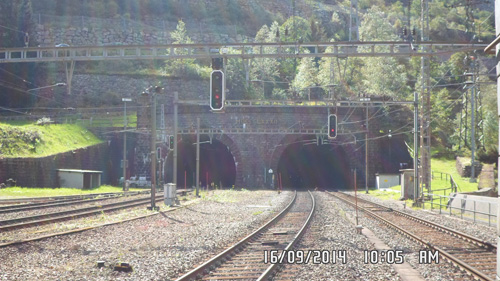
Gateway to Italy!
Opened in 1882, the Gotthard Pass forms one of the major crossings of the Alps from Germany, through Switzerland, to Italy. The other is the Simplon Pass, some 70km to the West. Traffic is constant 24/7 and combines both freight and passenger. Recently, as part of a group, I was privileged to have some cab rides in the banking locomotive used to assist heavy freight trains south-bound up the Northern ramp to the Gotthard Tunnel.
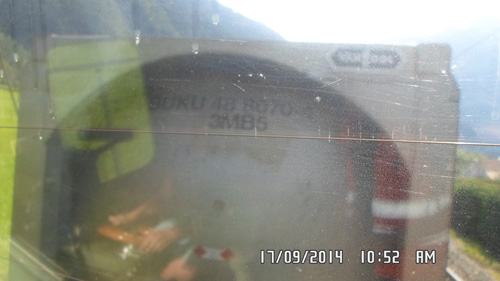
View from the cab!
In general traffic arrives from Germany, to the north, via Basel and is routed by weight and destination by the best route. The heavier more industrial trains tend to travel from Basel, through Rotkreuz and Arth Goldau to the Gotthard, possibly picking up a banker at Erstfeld. It is interesting to note that most of the traffic is south-bound and that very few banking locos are used to climb the Southern ramp!
For the technically minded, the whole line is standard 4'8 1/2" (1435mm) gauge, 15kV 16.7Hz~ single phase overhead catenary, maximum speeds 160km/h passenger (non-tilting), 100km/h freight).
The tunnel is entered at Göschenen from the North at an altitude of 1106m above sea level, exiting to the south, some 15km later, at Airolo, 1142m above sea level. On either side there is a ramp to the tunnel mouths from the 'ambient' landscape which each necessitate a 2.6%, or about 1:40, gradient. In the case of the Northern ramp, this is over a line distance of 29km.
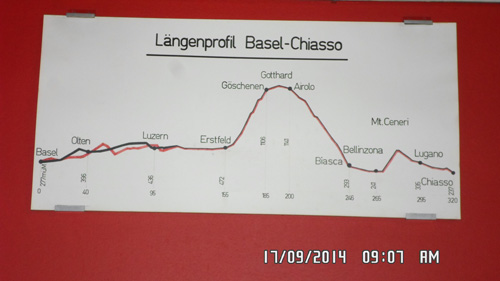
Line gradient profile.
The Northern ramp starts between Altdorf (442m above sea level) and Erstfeld (472m above sea level) in the Canton of Uri. It continues south past Gurtnellen where it enters a 360° spiral to gain 100m altitude, effectively in zero (ground) kilometres. The line continues to ascend to the village of Wassen. Here, we have a switch-back where the line enters the Wattinger Kehrtunnel before emerging, now heading North, through Wassen station. Leaving Wassen station, the line enters the Leggistein-Kehrtunnel to turn round and head South again, now at 1000m above sea level!
At this stage, it is worth giving mention to Wassen Kirch - the village church. Because of the route of this line, the church has become famous in that, as you approach from the North and look up from the right of the train you see the church. Minutes later, you look down from the right of the train and there's the church. A few more minutes and a shuffle to the left of the train and there's that church again! (Best view is immediately on the exit from the Leggistein-Kehrtunnel!) Looking from the left side of the train as you pass Eggwald, you will see the entrance to the Wattinger Kehrtunnel some 200m below which you entered after first sighting the church! In effect, you've travelled a long way but not really gone anywhere! The line now continues, reasonably ordinarily, to Göschenen.
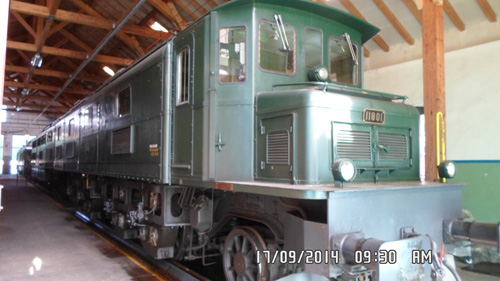
Ae8/14 at Erstfeld.
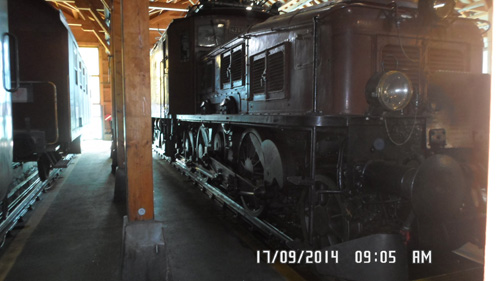
Ae6/8 at Erstfeld.
A freight train relies on chain-link couplings to haul the wagons. Various experimental locomotives were developed with sufficient horse-power to haul heavy freight trains over the Gotthard but coupling strength became a major issue. An extra 300 tonnes freight can be gained by adding a locomotive at the rear to 'bank' the train up the gradient. This locomotive serves two purposes: it is relieving the tension on the couplings of the train and it is providing a 'back stop' should anything fail. The maximum tonnage with banker is 1600t.
Erstfeld is the last depot at the bottom of the Northern ramp. It has 6 through roads (1, 2 & 4 are passenger platforms, 3 is a dead-end on the southern side). Being Switzerland, all lines are bi-directionally signalled, i.e. anything can go anywhere on any track, in theory!
A friend of mine, who is involved with the SBB Historic group, made myself and several other of her friends aware that it could be possible to arrange a series of cab rides from Erstfeld to Göschenen over a period of 48 hours. (Note 48 hours, not 2 days! Rides might be available at 03:00 because of the heavier freight use overnight when there are no passenger services!) As it happened on this trip, we were able to schedule our rides more-or-less as we wanted during the day; it was still a long and busy day with one pair 'on duty' from 06:00 until 02:00 the next day!
Travel from London to pretty much anywhere in Switzerland is possible in one day by train.
I left home on Sunday afternoon to travel to London before catching the 09:13 Eurostar to Paris on the Monday. Crossing Paris to Gare du Lyon, I took the TGV to Basel and changed to Zurich. I then took the Luzern train to Zug where I transfered to the local S2 Suburban to arrive in Erstfeld at around 20:00 in time for a meal.
On Tuesday, I did some research! Several hours on Erstfeld station, including talking with the signalling control, both friendly and helpful, on the platform before travelling to Göschenen to get some photos/footage of the tunnel mouth. Back to Zürich station for a meal (The Federal on Zürich's station concourse is well worth visiting, serving most of Switzerland's own beers) then back to Erstfeld to meet with some of my recently arrived friends.
On Wednesday, my friends and I reported to the SBB offices at Erstfeld and met our hosts and guides for the 48 hour experience.
After being greeted by our drivers and hosts, we were given an oversight of the nature of the work carried out at Erstfeld depot and the reason for the new depot expansion (still in construction), i.e. to provide a home for the maintenance teams for the new Gotthard Base Tunnel, due to open in the next few years. Base tunnel = tunnel at the foot of the mountain, therefore no need to climb before entering. You will recall the earlier picture of the line profile; the base tunnel connects Erstfeld with Biasca almost on the level. OK, so it's some 40km more tunnel but it's a much shallower gradient, climbing to no more than 550m above sea level and it's some 25km less track than the 'over the top' route!
Taken to the 'classroom', an historic coach fitted out as a buffet, we were told the reasons behind the banking process and issued with our personalised 'souvenir' guides to the visit.
Together with Pascal, our driver, Guido, our host and Clive, my fellow enthusiast, I boarded Ae6/6 loco 11411, Zug, and departed the shed for duty.
Technology has not escaped the railways and two laptop computers were soon in use by our hosts to view our duty and also to locate our target train. As we headed towards the end of the headshunt to join our train, we noted that it was currently some 7 minutes away at Flüelen.
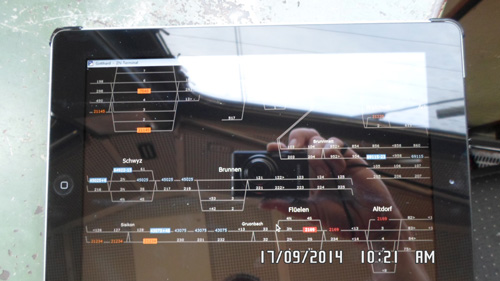
Location of train No. 43075
As my colleagues moved to the other cab, I requested permission to join them later so as to record the arrival of our train.
Incoming train 43075, 104 Axles, 1599 Tonnes.
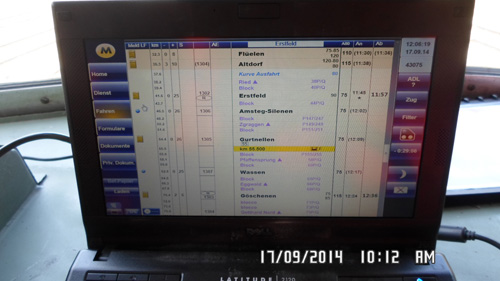
Our schedule.
Joining our train!
You will observe, during this video, that on the left side are two rescue trains for the Gotthard tunnel. These are fitted with high pressure water jets with foam to blanket any fires which may break out in the tunnel.
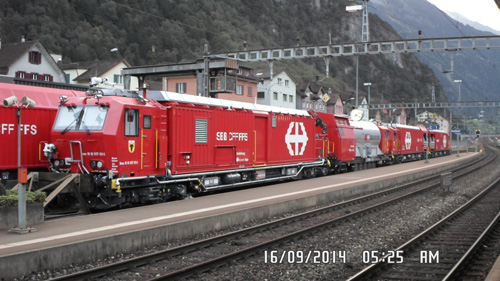
Rescue Train.
It is noteworthy that one of these trains was brand new and undergoing commissioning for the new base tunnel. We were to see this out on the line later in the day! Our loco is now coupled to train 43075 and we are ready to assist it to Göschenen.
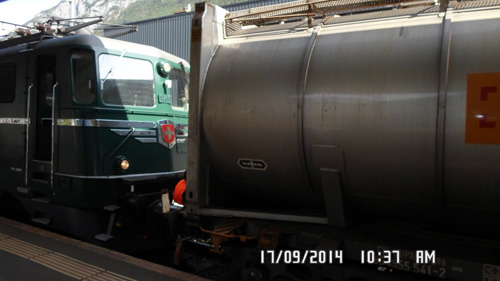
Attached!
At various curves on the route, I tried to photograph our full train; the best I managed was not far from Erstfeld and still did not show the Re10/10 loco hauling us!
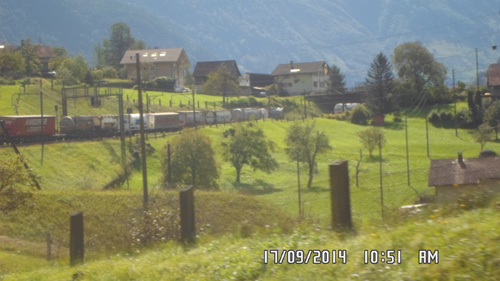
Our train!
The banking process dictates that, for our style of train, we, as the banker, must maintain a current to all 6 drive motors of 1700 Amps. The cab is fitted with a suitable meter which indicates both the amperage drawn by each motor and also the line voltage and current drawn from the catenary.
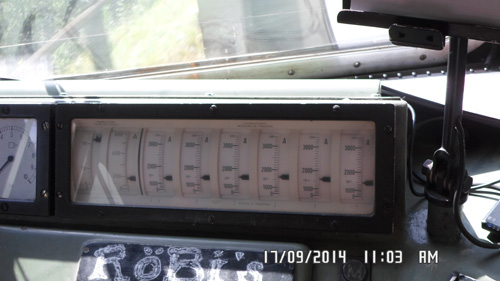
Left to right - Catenary voltage, current drawn from catenary, current drawn by each of six traction motors
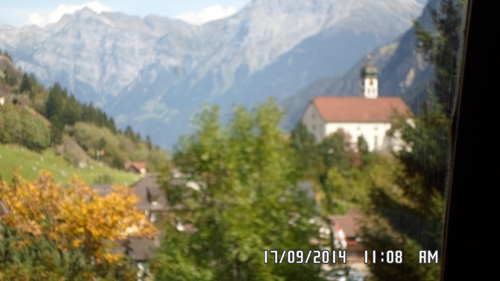
All too soon, we reach Wassen, so here's the church on the second (north-bound)...
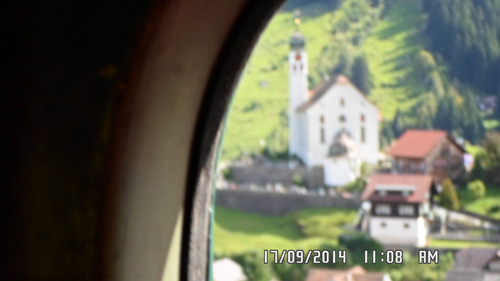
...and third (south-bound) passes!
We arrive in Göschenen and uncouple, so time for a photo opportunity. Remember, this is Switzerland and YOU are responsible for YOUR OWN safety, so out on the track bed we go!
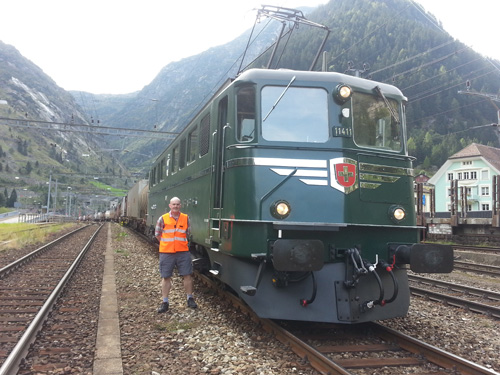
Me with loco 11411 and train 43075 (no longer coupled) at Göschenen (photo: Clive Dean)
We are held at Göschenen for several minutes before we can return to Erstfeld due to a north-bound passenger service and a south-bound freight.
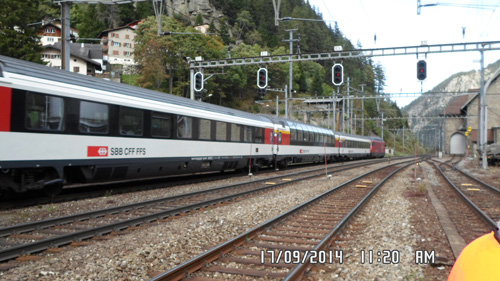
Locarno - Basel passenger service.
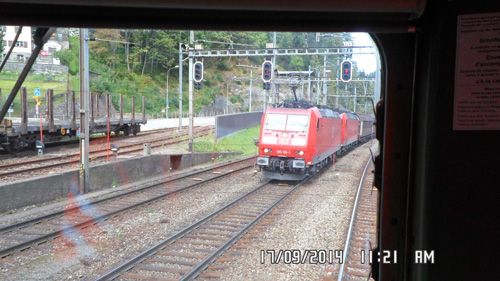
South-bound freight.
On the way back, I pushed my camera to its limit to shoot a real-time video of the view from the cab; sorry, but it's in three sections!
Göschenen to Gurtnellen.
You will note how many crossovers there are on this route. As mentioned, Swiss railways are signalled bi-directionally and in this video, you will observe that, due to engineering works, we safely 'wrong line' Wassen station! On a later run, this work had completed and we worked normal line through the station.
Gurtnellen to Erstfeld headshunt.
Erstfeld headshunt into depot. To the right, you can see the new construction works to support the Gotthard base tunnel.
Time for lunch courtesy of SBB Historic in the crew mess, then two more runs, this time with 11402, Uri.
After the third trip, our souvenir guides were updated with the train details and we were given copies of the train diagrams which we had worked.
Clive and I now bade farewell to our hosts, Guido and Pascal, before being being given a guided tour of the Control Centre (Zugkontrolleinrichtungen or ZKE) at Erstfeld station. In short from this single room, continuously staffed by one person per shift, the state of every train in Switzerland is monitored. Axle loading, wheel loading and temperature, train gauge, etc. are just some of the parameters monitored here and the operator has the ability and authority to halt a train if any of it's parameters go out of, or approach defined limits.
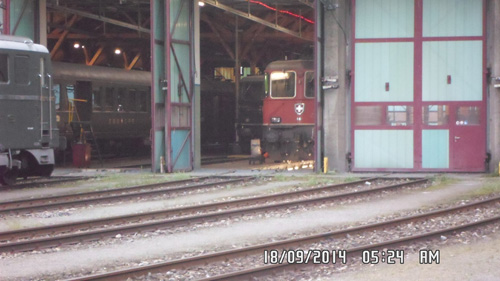
On Shed.
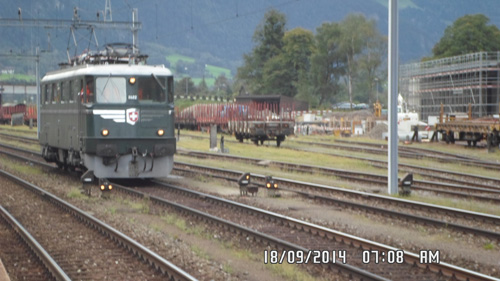
11402 Uri with two more friends on board!
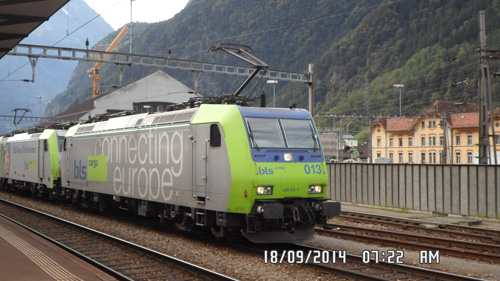
Double-headed 485-013 + 486-508 sporting BLS Cargo livery head north with a tanker load.
On Thursday, after a wander around the yards at Erstfeld , I paid a visit to the Luzern Verkehrshaus to view their model of the line from Erstfeld to Göschenen. Walking around the model, various scenes are explained in detail; let's have a look at Wassen:
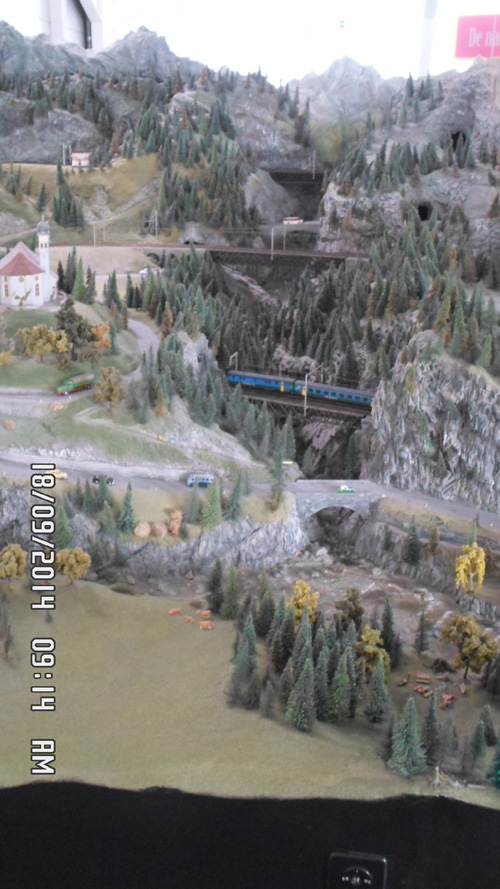
Three levels of the switch-back (Note the church about 2/3rds up the left side).
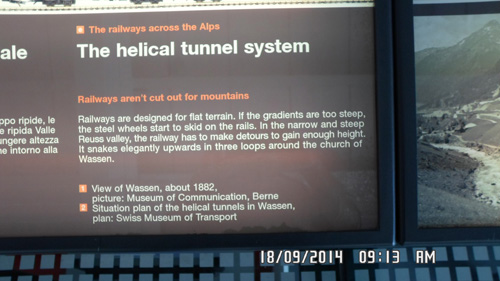
A brief explanation.
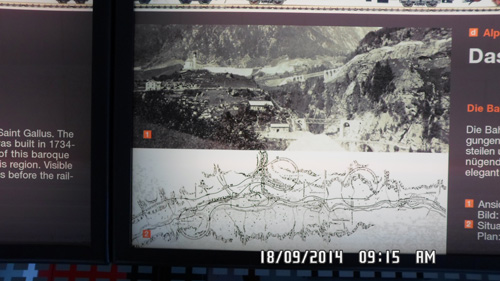
A similar view trackside with a map showing the track plan.
Friday, after an early breakfast, it was time to retrace my steps back via Zürich, Basel and Paris to St Pancras and home.
This was a week well spent but, with the opening of the new Base Tunnel due in June 2016, one which is unlikely to be repeated. It won't be forgotten in a hurry!
Poigniantly, outside the Verkehrshaus stands their latest exhibit:
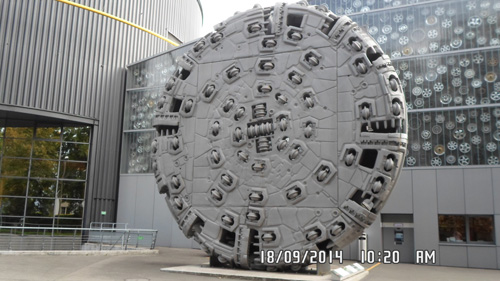
One of the cutting heads used in the new Base Tunnel.